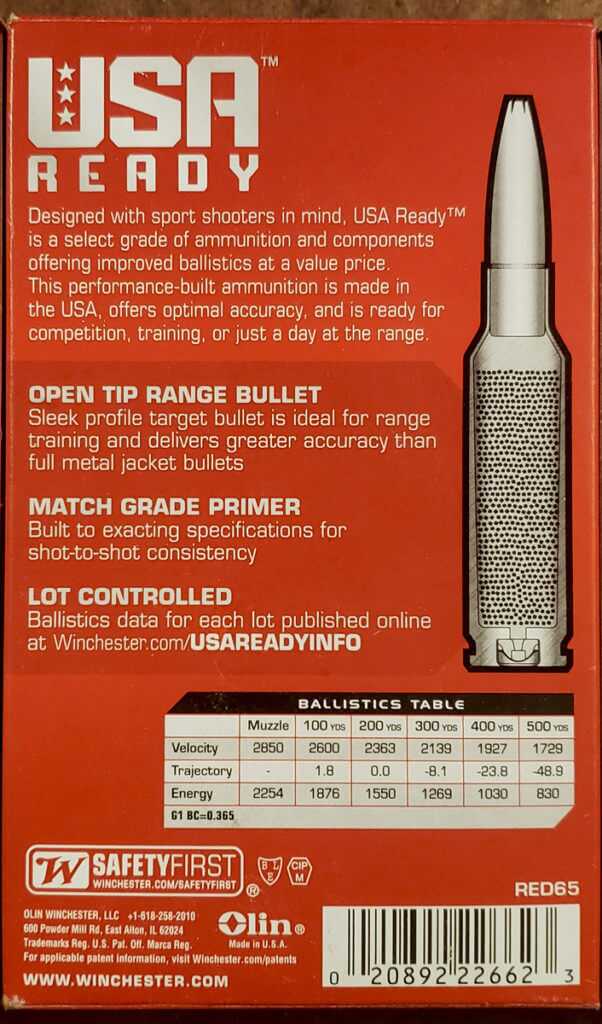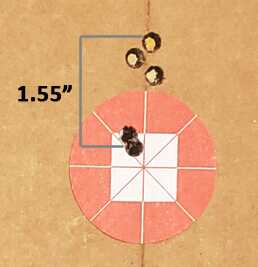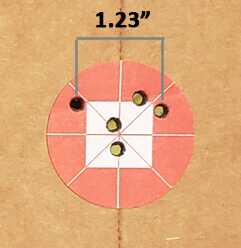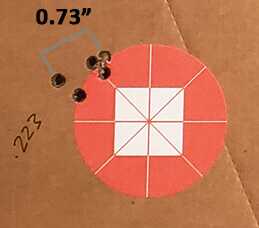If you walk into most larger firearms retailers looking for range ammo you’ll find shelves full of options and pretty soon every box of ammo kind of looks like the next one. Generally speaking, range ammo for most shooters is going to be some form of full metal jacket bullet, regardless of caliber, that is good on pricing but pretty poor on accuracy. The USA Ready ammunition bridges that gap by providing options in 9mm, .40S&W, .45ACP, .300BLK, .223REM, .308WIN, and 6.5CM that is more accurate and consistent than FMJ ammo but more affordable than match-grade options. Winchester accomplished this by using premium components like match-grade primers and specifically designed bullets.
Shooter Ready!
For this review, I bought ammunition in .223 Remington, .308 Winchester, and 6.5 Creedmoor to use in two Remington 700’s and my semi-auto precision rifle. All three calibers utilize an open tip bullet with a cannelure but it’s important to note that these are not open tip match bullets. A light crimp is used on the case mouth to keep the bullet in place so these will work equally well in semi-auto rifles as they do in bolt guns.

The boxes themselves are pretty standard for Winchester but the bright red certainly stands out and draws your eye to it. On the back of the box, there’s the obligatory marketing info, but also a basic data chart that includes the G1 ballistic coefficient of the bullet. This isn’t that common and a welcome sight because typically you have to hunt this information down if you want to generate an accurate data table to use with optics.

If you want to get an idea of how your particular box of ammo should perform, the Winchester website has a feature that allows you to look up your lot of ammunition. Keep in mind that the data on the website is based on a 24” test barrel so it may not accurately match the muzzle velocity that you get from your rifle. To check that out, go here.
.308 Winchester
The .308 USA Ready was shot using my Remington 700 AAC-SD in an Accuracy International chassis, which has been a reliably accurate rifle over the years using match ammo. The USA Ready .308 bullet is a 168 gr flat base, open tip design that went 2,443 fps from the 20” factory barrel. This is a little over 200 fps down from the factory tested velocity but it is also from a shorter barrel. At 100 yards the accuracy wasn’t bad for self-described range ammo with an average for three 5-shot groups of 1.63″. This accuracy was 11% better than the factory results for this lot of ammunition.


6.5 Creedmoor
To test the 6.5 Creedmoor version I used my customized Remington 700 with a stainless steel Bartlein 1:8 twist barrel in an AX AICS chassis. The 125gr open tip bullet should’ve been going just north of 2,800 fps according to the factory data, but my rifle only achieved 2,764 fps. Every barrel is a rule unto itself and the colder December temps could explain this slight dip in velocity also. Accuracy was about on par with the .308 with an average of 1.65” for three 5-shot groups, but still significantly larger than the factory results of 1.00”. What was interesting was that for the most part, my zero did not shift with this ammunition despite the rifle being zeroed to Hornady’s 140gr ELD Match.


.223 Remington

Now, the .223 Remington was by far the best of the bunch, slinging a 62-grain bullet at 2,776 fps from an 18” stainless steel barrel with some really low ES and SD numbers. Accuracy at 100 yards was likewise impressive with a three-group average of 1.00”, easily beating the factory group of 1.29”. I’ve honestly seen match ammo that didn’t shoot this good and it only costs about $9 per box. The downside to this bullet is that it does have a relatively low BC so it’ll suffer as you try to push it out past 500 yards.


Train, Train, Train
I didn’t originally plan to take this ammunition out to farther distances, but I had the opportunity to work on some of my tripod shooting techniques while I was at the range. Initially, I shot the 6.5 Creedmoor ammo at 480 yards and with only a minor elevation adjustment I was ringing steel pretty consistently. Its performance at 100 yards wasn’t earth-shattering, but it was stacking rounds consistently on a 12” gong. That’s not bad when you consider that I was doing all of that off a tripod, from the standing position. I stretched the legs out on the .308 version of the USA Ready ammo also and it performed about the same on similarly sized targets so you’ll hear no complaints from me.

Conclusions
In the grand scheme of ammunition types, where does this ammo fit in? Well, I think it makes a great training round when you want to work on certain techniques or skills and don’t feel like wasting ammo that costs more than a dollar per shot. This could also be a great option for those that are shooting in multi-gun competitions that would appreciate an option that is cheaper than match ammo but better than your garden variety FMJ bullet. For me, the .223 62gr OT is one that I’m going to be exploring closer as an attractive option for 2-gun matches this year given its performance with a price that is nearly the same as regular ball ammo. Winchester also has pistol ammo options in the USA Ready line that are worth checking out too.

Thanks nice review.
This is totally selfish of me but is there any interest in a review of the Speer GD 62 grain bullet in 223? I’m currently working up loads for wild pigs and there website says this bullet is for self defense, no mention of hunting. I’m tired of the soft points from other manufactures getting mushed on the feed ramps of my AR.
Thanks, Ben from Arkansas
A good presentation with good data points. However, I would have much appreciated testing from 16-inch barrels, especially the .223, but the .308 as well. I do the majority of my shooting in those calibers with 16-inch barrels, as do many other shooters.
Charles,
I appreciate the feedback. You’ll be able to get a rough idea of the muzzle velocity out of a 16″ barrel by subtracting about 50 fps per inch from the published numbers above. That amount of loss seemed pretty consistent for the .223 and .308 that I tested, comparing them against the factory lot data. The accuracy will depend on your own rifle of course.